- 0 No item in your cart
- SUBSCRIPTION
- Classified Ads
- Technical Specifications
- Destinations
- Address book

- All the magazines
ECO 6: A catamaran for a self-builder

Article published on 11/05/2020
By Emmanuel van Deth
published in n°171 may / june
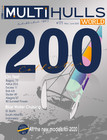
The ECO 6 fits into the ECOnomy range of catamarans offered by K-designs. These models are proposed in the form of plans, to be self-built in plywood/glass/epoxy.
Create a notification for "News from the builders"
We will keep you posted on new articles on this subject.
The stated objective is to have a proper cruising boat at a low price - the cost of materials for the hull shouldn’t exceed €4,000, then count on another 3,500 for deck fittings, interior and installing a full rig, and buying yourself a small outboard. The extra 50 cm (18”) compared to the ECO 5.5 provides more living space - thanks to the raised deck, something surprising for a catamaran only 2.84 m (9’4”) in beam. There is a saloon that can be converted into a double berth – positioned athwartships -, a galley in the starboard hull and a single berth - accompanied by a heads compartment (with a door!). The maximum headroom is 1.64 m (5’5”) at the entrance into the nacelle. The architect is proposing two different sail plans: traditional sloop or gunter-rigged.
Technical specifications:
Architects: K-designs
Length: 6 m (19’8”)
Beam: 2.84 m (9’4”)
Displacement: 360 kg
Mainsail area: 15 m² (161 sq ft)
Genoa: 5.8 m² (62 sq ft)
Code 0: 18 m² (194 sq ft)
Engine: 6 hp outboard
Cost of the plans: € 180
www.ikarus342000.com
Did you like this article ?

Share this article
Most-read articles in the same category.

MYBA 2024 - In Genoa for its 40th anniversary

EMMYS 2024 - Multihulls everywhere in Poros, Greece!
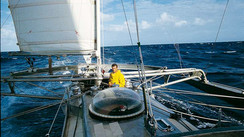
Pen-Duick IV - A replica to take on the 2026 Route du Rhum - Destination Guadeloupe!
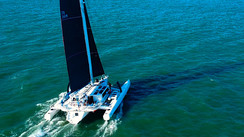
Rapido 53XS - A peak speed of 24 knots during initial seatrials!
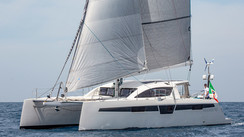
C-Cat Catamarans - A week of private seatrials

Veritax - Tax and fiscal specialists
What readers think.
Post a comment
No comments to show.
Follow us on
Vous avez ajouté " " à vos favoris., vous avez supprimé " " de vos favoris., in order to add this article to your favorites, please sign in..
The ECO 75 power cat is the big brother of the ECO power cat. Designed along the same lines and with the same philosophy. Easy to build boat by an amateur. Construction is the time proven plywood/glass fiber/Epoxy composite system. Nothing can match this system for weight, costs and easy of construction. Besides this advantages no maintenance will be necessary over many years.
The hulls start with a deep V on the bow and a wide V at the transom. So the boat will be sea worthy. The hulls are designed for medium speed. Speed with a 25 HP engine will be around 25 knots full power and 18 knots at half power. So the boat will be very ECOnomical to run and maintain.
One attractive features is the front cockpit. This is not only a nice place for sun bathing but also a safe place for anchor maneuvers. The front hatch makes it not necessary to walk over the deck in a bad weather situation.

The inside lay out with the enclosed bath room speaks for it self. In hulls have standing height. The height on the bridge deck saloon is 1,20m. Enough for comfortable seating on the settee. The boat is build from 8 and 6mm plywood over stringers. The construction manual describes an easy way for fairing. In the end this is the quickest way to build the boat. The whole boat is covered with fiber glass and painted with PU paint.
The plans consists of 20 drawings. The technical drawings are to scale 1 : 1. File format PDF (DXF files available. The 14 pages manual gives a description of the construction of the boat.
Click HERE for sample drawing
The empty weight of about 410 kg is not much for a craft of this size with this lot of accommodation. A bonus of the low weight is that the craft can be trailered behind a modest sized car.
The load capacity is higher as its own weight ( empty weight 410 kg load capacity 480 kg). By placing a double berth transverse at the bow much room is gained for the saloon. Good accommodation is paramount in my view on a houseboat. A big open saloon, a good sized cockpit for socializing also. The saloon and the cockpit are at the same level. The standing headroom is over the whole length of the interior 1,94 m (6 feet, 5 inch).

The bench can be used as an other double berth at night. A fair sized bathroom is an other asset and nice to have.
The cabin sits on the top of the hulls. So the hulls are basically empty. There is sufficient space for water tanks till 200 liter. Brown water tanks from the toilet and pantry. Batteries for electric drive(s): Of course closed cell batteries have to be used.
If a gas cooker is used the bottle can be placed direct underneath the pantry with ventilation openings at the side of the deck house far above the water line. The hulls have 1400 liter volume for floatation, so the craft can not sink.
Construction is the proven and easy to learn wood/glass/Epoxy composite construction system. The design is on 5 bulkheads and wooden stringers. Easy to learn also for a novice in boat building. As mentioned the craft is light. A hull weights around 50 kg when finished. So turning the finished hulls can be if need be done by one person. Building up the bridge deck is the same. The bridge deck is build up from 12 mm plywood. A 12 mm plywood panel weights typical 18,3 kg. So can be handled by one person to. By the way all other plywood used is 6 and 4 mm plywood. Laminated together where need. Example: Keel to chine is build up from two layers of 6mm plywood.
The hulls slide easy and effortless through the water. So not much power is needed to propel the boat. Powering the boat depends where the boat is used. The boat can be powered for instance with small electric trolling motors. Example: One at the bow two at the transom. The will have 150 pound of trust good for about 8 km per hour. This is the speed limit on many channels and recreation resorts.

Or on each transom an outboard with about 20 HP. This would be good for around 20 knots. A bit fast, all the cutlery will jump in the cabinets.

My favorite drive for this craft is the surface piercing drive, with a 15 HP engine. If you search careful the complete drive will cost about US $ 900,00. In this configuration the boat will give you about 12 knots of speed. The engine is a two cylinder four stroke engine, air cooled. But with a foam lined cover the high wining noise of the fan cooling can be diminished by 80 %. So the engine would be not more noisy as two outboard engines.

Surface piercing drives are also known as mud drives. For maneuvering in a port I would add an electric trolling motor at the bows.
The development of new houseboats is almost standing still. So here some new and a bit unconventional ideas to change that.
Maisons 04/20/2015 B. Kohler K-designs France
These plans available at Duckworks
- NEW : Our Second-Hand catamarans
- New Windelo 50 Adventure
- New Windelo 50 Yachting
- New Windelo 50 Sport
- New Windelo 54 Adventure
- New Windelo 54 Yachting
- New Windelo 54 Sport
- Our Second-Hand catamarans
- The Windelo Innovations : performant, comfortable and eco-friendly catamarans
- Ocean Future : our ecological approach
- The Windelo Services
- Charter a Windelo catamaran
- The Windelo Shipyard
- Windelo Team
- Recruitment : Join the Windelo team

WINDELO, ECO-ADVANCED CATAMARANS
Performance, events where to meet windelo.

000 days 00 hours 00 minutes 00 seconds
Windelo catamarans A Windelo for you
At Windelo, we know you & your crew are unique. Whilst we all have the same drive for sailing & passion for the sea, our dreams of adventures, travels, and sailing plans are varied.
That’s why we offer Windelo in different sizes and each available in three versions : Adventure , Yachting and Sport .
An extensive options list covering almost anything you’ll need is available to combine with either of the versions. Any special requests ? Our team is here to help !

15.24 meters
7.95 meters
Light displacement
From 1 045 000€ EX-VAT

From 1 130 000€ EX-VAT

From 1 150 000€ EX-VAT

16.24 meters
7.98 meters
From 1 380 000€ EX-VAT

From 1 470 000€ EX-VAT

From 1 495 000€ EX-VAT
The environment is our priority.
Windelo’s innovative catamarans, combining recycled and bio-sourced materials, electric motors, and renewable energy sources as prime, received a special mention for “Sustainability” from the European Yacht Of The Year 2022!
Innovation is the way to go.
Windelo is the desire to expose oneself to something new, innovative, powerful, and bigger than oneself. So, we seek innovations in eco-composite materials, industrialization techniques, and sailing uses to propel a new economic reality.
Performance , our DNA.
Designed by architects Christophe Barreau and Frédéric Neuman, Windelo catamarans are recognizable by their slim, well-balanced hulls, designed to enhance our catamarans’ performance and seaworthiness. True bluewater cruisers, Windelos are built for the pleasure of sailing and exploring long distances and getting their fast.
The comfort of your home.
The Windelo team designs spacious modern catamarans that offer maximum comfort, even during your long sailing journeys. The key was to provide a feeling of both space and light and an ultimate open-plan layout, eliminating the barriers between indoor and outdoor space by creating a vast living area. Rethinking how to live and sail a catamaran means life on board is cleverly organized right by the center of gravity for increased stability and comfort.
They chose Windelo !
And they share their stories.
The Windelo Spirit by Gautier and Olivier Kauffmann, founders of the company
“Windelo is the desire to expose oneself to something new , innovative , more significant than oneself. To seek innovations in materials, industrialization techniques, uses and to propel a new economic reality.
We design and build blue water cruisers that offer comfort while you explore the world. Our Windelos are designed for sailors who dream of adventure and memorable moments, cruising the seas and oceans while respecting our planet.
We want to be part of this transformation related to respecting our environment ; and respecting nature with all its richness and beauty that it offers, and not forgetting the people who are part of this adventure. Our team is at the heart of the project, and we seek to build and form a team of passionate Windelo sailors”.

OUR LATEST NEWS
Find all the Windelo news.

BECOME A WINDELO SAILOR
Meet the Windelo sailors and find all our latest job opportunities.

VIRTUAL TOUR
Discover the New Windelo 54 Yachting.

Our ecological approach

New Windelo 50 Yachting – A performance catamaran designed for comfort and green autonomy

Owners Testimonial – Meet Manon & Robert owners of B Cube, a Windelo 54 Adventure

Windelo Handover Experience – 3 days to start handle your Windelo
Subscribe to our newsletter and receive all the Windelo News!
SALES MANAGER
Windelo is a new conception brand of innovative catamarans. Ecology is at the heart of the company with the ambition to significantly reduce the environmental impact of our boats. A range of 44 to 60 foot catamarans offering sailors the opportunity to sail with pleasure and safety on eco-friendly boats.
In full development, we are hiring a sales manager:
JOB AND MISSIONS: Managed by the director of the company, and in connection with our various services and partners, you are a key player in the launch of this new brand.
Real project manager: 1. You co-build the Windelo sales and services office, 2. You recruit, train, and drive progressively a team of passionate experts, 3. You develop and innovate in the strategy of selling Windelo boats in Europe, 4. You recruit and lead a global network of sales partners, 5. You co-build and animate the company’s service strategy: port mapping places; insurance and financing; training; owner’s manual etc.
YOUR PROFIL 1. Passionate about sailing, you practice regularly, 2. Your sense of service and customer leads you to satisfy your customers every day, 3. You are enthusiastic and motivated to work in a start-up, 4. You have 2 to 5 years’ experience in the sale of boats, 5. Bilingual French – English, you also speak a third language: German, Italian, or Spanish.
EVOLUTIVE JOB Director of sales
AVAILABILITY / PLACE OF WORK 1st Quarter 2019 / Occitanie Region, Canet en Roussillon FRANCE
TYPE OF CONTRACT AND REMUNERATION Permanent contract / fixed to be defined according to experience + variable.
If you are a passionate of sailing and this challenge to participate in the development of a company in full creation arouses your enthusiasm, welcome to send your application by e-mail to: contact@windelo-catamaran.com
RESPONSABLE DES VENTES
Windelo consiste en la création d’une nouvelle marque de catamarans innovants. L’écologie est au coeur de l’entreprise avec pour ambition de réduire fortement l’impact environnemental de nos bateaux. Une gamme de catamarans de 44 à 60 pieds offrant aux marins la possibilité de naviguer avec plaisir et sécurité sur des bateaux éco responsables.
En plein développement, nous recrutons un(e) responsable des ventes
POSTE ET MISSIONS
Managé(e) par le directeur de l’entreprise, et en lien avec nos différents services et partenaires, vous êtes un acteur clefs du lancement de cette nouvelle marque. Véritable chef de projet :
1. Vous co-construisez le bureau des ventes et des services de Windelo, 2. Vous recrutez, formez, et animez progressivement une équipe d’experts passionnés, 3. Vous développez et innovez dans la stratégie de vente des bateaux Windelo en Europe, 4. Vous recrutez et animez un réseau mondial de partenaires de vente, 5. Vous co-construisez et animez la stratégie de service de l’entreprise : mapping des places de port ; assurance et financement ; formation ; entretien ; manuel du propriétaire etc.
VOTRE PROFIL 1. Passionné(e) de nautisme, vous naviguez régulièrement, 2. Votre sens du service et du client vous anime pour satisfaire vos clients au quotidien, 3. Vous êtes enthousiaste et motivé(e) à l’idée de travailler en équipe dans une « start-up », 4. Vous disposez de 2 à 5 ans d’expérience dans la vente de bateaux de plaisance, 5. Bilingue français – anglais, vous maitrisez également une troisième langue : allemand, italien, ou espagnol.
POSTE EVOLUTIF Directeur des ventes
DISPONIBILITÉ / LIEU DE TRAVAIL 1ier Trimestre 2019 / Région Occitanie, Canet en Roussillon FRANCE
TYPE DE CONTRAT ET REMUNERATION CDI Cadre / Fixe à définir selon expérience + variable.
Si vous êtes un(e) passionné(e) de l’univers du nautisme et que ce challenge de participer au développement d’une entreprise en pleine création suscite votre enthousiasme, merci d’adresser votre candidature par e-mail à : contact@windelo-catamaran.com
As part of the creation of new types of catamaran made in Occitanie, an audacious choice of ecological innovation has been selected in partnership with the Materials Center of « Mines d’Alès » (C2MA – IMT MINES ALES) (Gard, France). It’s a question of combining ecological performance in terms of minimizing the environmental footprint and structural resistance, and this, in a global approach of circular economy on all parts of the boat. To do this, and in connection with the IMT MINES ALES, Windelo has relied on the use of secondary raw materials, competitive virgin petroleum-based materials, that fully comply with the specifications in terms of mechanical performance. This is a real first step to the development of a 2.0 fleet ships fully integrated into the challenges and ecological challenges of the 21st century.
Associated with an ecological approach of circular economy integrating a not insignificant part of competitive secondary raw materials from virgin materials, the architectural design and the resistance of materials on the new Windelo catamarans are mechanically tested in the Materials Center of « Mines d’Alès » (C2MA – IMT MINES ALES) (Gard, France) in connection with the architects and designers of the project. The design of the ship, and in particular the hulls and bows, go through a search for efficient structuring and arranging of materials composing it, combined with a mechanically optimized geometrical assembly. To this end, specific test developments, such as the study of distortion of the structure and of the panels constituating the hull of the ship, are studied by digital image correlation techniques coupled with standardized strength tests.
Founder of Catana
“The cruising program for this new boat raises the question of the antagonism between the search for performance under sail and the pleasure of navigation, and the development of pleasant living spaces. The originality of the answer is provided here in the arrangement of the cockpit bringing together the helm and maneuvers to the center of the boat and in the arrangement of living space that occupies the rear of the nacelle.
Just behind the mast the outer cockpit offers two helm stations protected from the wind and spray, a beautiful view of the sails and bows, and allows to have all the maneuvers on hand while limiting the needs to circulate on the bridge. Out of navigation, the cockpit can be more widely protected from the outside and open to the rear space.
Fully opened behind this cockpit, we have not developed two living spaces duplicating one inside the other but a single large space which is ajustable. We have focused our efforts on the geometry of the material and visual limits of this space and on the opening kinematics of the bays. Once opened, they “disappear” to transform the interior into an exterior. The generosity of these openings also allows to modulate the ventilation of this space by playing on a wide range of opening on its four sides
This work on the modularity and the disappearance of limits is found at the extreme rear of the nacelle, with an articulated platform to the davits transforming it into a floor when anchored, and in the rear cabins, whose wide turning porthole eliminates the angle between side plating and back side. The cabin space is therefore generous despite the relative narrowness of the hulls.
All these choices allow us to combine a contained hold of the nacelle, pledge control of the weight estimate, to a generous living space, with a central part given to navigation and maneuvering. The slenderness of the forward spikes, the significant free height under the platform, and the attention paid to the centering of the masses, complete the marine qualities expected for an offshore navigation program.
The other originality of the project brought by this new construction site is in the approach of “eco-design” on materials and construction. Strongly limiting the use of molds, the latter brings a greater margin of freedom in the variations and evolutions of the boats thus conceived. ”
Christophe Barreau et Frédéric Neuman
Architects and Naval Engineers
Who could know if it is the father or the son who is the most passionate? It doesn’t matter. The important thing is to write an innovative project within a family culture, for today and for generations to come. Hand over the guiding light, this is Olivier Kauffmann’s will. “At first I wanted to make my own boat, for me and my family; go on trip around the world living on a efficient and pleasant catamaran. I dreamed of a new quality of space. Today, the dream has matured, and I want to share it with the great family of sailors. »
Windelo is the desire to expose us to something new, innovative, powerful, bigger than oneself. To seek innovations on materials, techniques of industrialization and uses to impulse a new economic reality. “We want to be part of this transformation related to the respect of our environment, it is for us, essential to work in this respect of men and nature. Men are at the heart of the project with the desire to recruit and form a passionate team, surrounded by experts recognized as the best in their field.
And the innovation doesn’t stop here, because the constructive process makes it possible to envisage fast evolutions from one boat to another while remaining well priced. An ambitious and respectful project ; Welcome to the Windelo adventure.
Dans le cadre de la confection de nouveaux types de catamaran made in Occitanie, un choix audacieux d’innovation écologique a été retenu en partenariat avec le Centre des Matériaux des Mines d’Alès (C2MA – IMT MINES ALES) (Gard). Il s’agit à la fois d’allier performance écologique en termes de minimisation de l’empreinte environnementale et résistance des structures, et ce, dans une démarche globale d’économie circulaire sur l’ensemble des parties du bateau. Pour ce faire, et en lien avec l’IMT MINES ALES, Windelo a misé sur l’utilisation de matières premières secondaires, compétitives des matériaux pétrosourcés vierges, et parfaitement conformes au cahier des charges sur le plan des performances mécaniques. C’est un réel premier pas vers l’élaboration d’une flotte de navires 2.0 s’intégrant complètement dans les enjeux et défis écologiques du XXIème siècle.
Associées à une démarche écologique d’économie circulaire intégrant une part non négligeable de matières premières secondaires concurrentielles des matières vierges, l’architecture de conception et la résistance des matériaux des nouveaux catamarans de Windelo sont éprouvées par des tests mécaniques réalisés au Centre des Matériaux des Mines d’Alès (C2MA – IMT MINES ALES) (Gard) en lien avec les architectes et designers du projet. La conception du navire, et en particulier les bordées et étraves, passe par une recherche de structuration performante de l’agencement des matériaux le composant, combinée à une géométrie d’assemblage optimisée sur le plan mécanique. Pour ce faire, des développements d’essais spécifiques, comme l’étude de la déformation de la structure des panneaux constituant la coque du navire, sont étudiés par des techniques de corrélation d’image numériques couplés à des essais de résistance mécanique normalisés.
La rencontre avec Olivier et Gautier a été une agréable surprise pour moi, dès l’exposé de leur projet, j’ai vu réunis tous les ingrédients d’une réussite, l’expérience de gestion d’entreprises mais avec une modestie rassurante, le souci de former une équipe des meilleurs experts (sourire) et une réelle écoute de leurs avis. Au fil des rencontres, les discussions ont ravivé mes souvenirs de la création puis du développement de Catana. Les mêmes motivations, la même recherche de perfection, la même audace teintée de modestie que nous avions au départ du projet. Windelo est centrée sur le produit ; une ligne de catamarans performants construits avec les techniques les plus modernes. Je n’en avais pas conscience à l’époque mais je crois que le succès d’un bon bateau vient de cette passion pour la mer avec la volonté de marier confort sécurité et performance. Je retrouve ici cette passion, et aujourd’hui ce qui a fini de me conquérir c’est le souci de préservation de la nature, tant dans les matériaux choisis que dans les méthodes de production.
Le programme de grande croisière auquel se destine ce nouveau bateau pose la question de l’antagonisme entre d’une part la recherche de performances sous voiles et du plaisir de navigation, et d’autre part l’aménagement d’espaces de vie agréables et généreux. L’originalité de la réponse apportée ici réside dans la disposition du cockpit rassemblant poste de barre et manœuvres au centre du bateau et dans le traitement de l’espace de vie qui occupe l’arrière de la nacelle. Juste en arrière du mât le cockpit extérieur offre deux postes de barre protégés du vent et des embruns, une belle vue sur les voiles et sur les étraves, et permet d’avoir l’ensemble des manœuvres à portée de main tout en limitant les besoins de circuler sur le pont. Hors navigation, le cockpit peut être plus largement protégé de l’extérieur et s’ouvrir sur l’espace arrière. De plein pied en arrière de ce cockpit, nous n’avons pas aménagé deux espaces de vie dupliqués l’un à l’intérieur et l’autre à l’extérieur mais un seul grand espace dont le degré d’ouverture est très largement modulable. Nous avons porté notre effort sur la géométrie des limites matérielles et visuelles de cet espace et sur les cinématiques d’ouverture des baies. Une fois ouvertes elles « disparaissent » pour transformer l’intérieur en extérieur. La générosité des ouvrants permet également de moduler la ventilation de cet espace en jouant sur une large gamme d’ouverture sur ses quatre côtés Ce travail sur la modularité et sur la disparition des limites se retrouve à l’extrême arrière de la nacelle, avec une plateforme articulée aux bossoirs se transformant en plancher au mouillage, et dans les cabines arrières dont le large hublot tournant fait « sauter » l’angle entre bordé latéral et face arrière. L’espace de cabine est donc généreux malgré la relative étroitesse des coques. L’ensemble de ces choix nous permet de conjuguer une emprise contenue de la nacelle, gage de maîtrise du devis de poids, à un espace à vivre généreux, avec une place centrale accordée à la navigation et aux manœuvres. L’élancement des pointes avant, l’importante hauteur libre sous nacelle, et l’attention portée au centrage des masses, complètent les qualités marines attendues pour un programme de navigation hauturière. L’autre originalité du projet apportée par ce nouveau chantier se trouve dans l’approche d’« éco-conception » portant sur les matériaux et le mode constructif. Limitant fortement le recours aux moules ce dernier apporte une plus grande marge de liberté dans les déclinaisons et évolutions des bateaux ainsi conçus.
Qui sait lequel du père ou du fils est le plus passionné ? Peu importe. L’important ici est d’écrire un projet innovant au sein d’une culture familiale, pour aujourd’hui et les générations à venir. Passer le flambeau, le relais ; c’est la volonté d’Olivier Kauffmann. « Au début je voulais me faire mon propre bateau, pour ma famille et moi ; partir faire un tour du monde sur un catamaran performant et plaisant à vivre. Je rêvais à une qualité d’espace inédite. Aujourd’hui, l’envie a mûrit, et je tiens à le partager avec la grande famille des marins ».
Windelo c’est l’envie de s’exposer à quelque chose de nouveau, d’innovant, de performant, de plus grand que soi. Aller chercher des innovations sur des matériaux, des techniques d’industrialisation, des usages et impulser une nouvelle réalité économique. « Nous voulons faire partie de cette transformation liée au respect de notre environnement, c’est pour nous indispensable d’œuvrer dans ce respect des hommes et de la nature. Les hommes sont au cœur du projet avec la volonté de recruter et former une équipe de passionnés, entourés d’experts reconnus comme les meilleurs dans leur domaine ».
Et l’innovation ne s’arrête pas là, car le process constructif permet d’envisager des évolutions rapides d’un bateau à un autre tout en restant bien placé en prix. Projet ambitieux et respectueux, bienvenu(e) dans l’aventure Windelo.
Boat Profile
Eco 5 Power Cat
A catamaran for cozy cruising
From Issue March 2016
W as it time for another boat? In the 1980s, it was a 16′ sailing dinghy that awakened my wife Barbara and me to the beach-cruising pleasures of the San Juan Islands in Washington’s Puget Sound. In the ’90s, it was a 19′ lug-rigged double-ender for oar, sail, and outboard that extended cruising to Desolation Sound. Then came a 20′ catamaran, sporting a wing mast with square-topped mainsail, that got us inside a comfortable cabin while offering exciting sailing in moderate conditions. But as years went by, sitting out in the weather and hauling sheets took its toll. Sailing was exciting when the wind was up, but boring in light summer winds. Why bother with sailing if we could motor at 10 knots? Was it time for a gasser?
And so it was, and we decided upon the Eco 5 Power Cat by Bernd Kohler in France. Its narrow hulls, wave-piercing bows, space-age profile, and three-tone color scheme really made it a looker. At 5.5 meters, it was about the same size and accommodation as our 6-meter sailing cat, and still trailerable behind our compact SUV. The twin 5-hp outboards specified in the plans were to drive the EcoCat at an economical 10 knots and spin it around in circles. Having them mounted on the transoms should eliminate weed pickup, as well as the between-hull wave buildup working against a centrally mounted outboard. I ordered plans, and the digital files came quickly via email.
The plywood-on-frame EcoCat is simply built, using chines sprung around widely spaced bulkheads. I opened the DXF files on an older Mac Cube still running Drawing Board CAD from Ashlar Vellum. With CAD, I made some design changes for a bit more cabin headroom, bigger windows, storage lockers forward, and extended cockpit sides complementing the cabin profile.
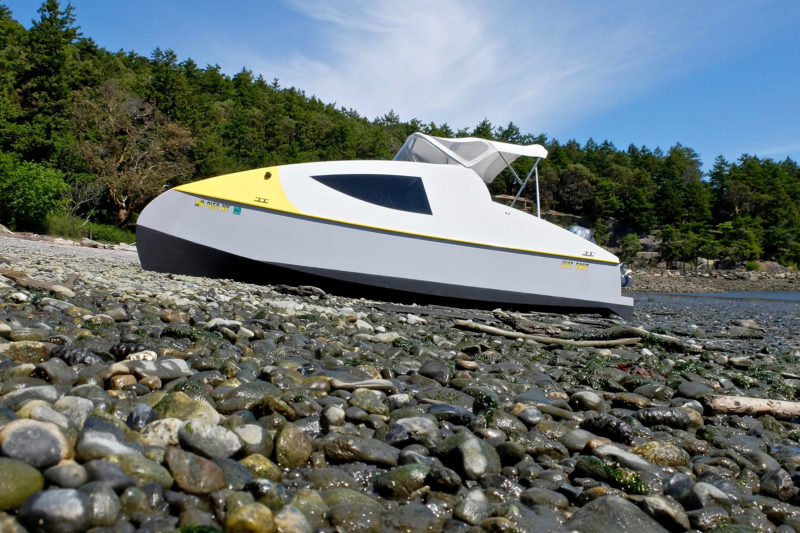
The Eco Cat rests comfortably on the cobbles between tides. There’s room aboard for an inflatable kayak when a dinghy is required if the Cat’s at anchor.
Once I had the design tuned to suit our needs, I nested parts for economical use of plywood sheets, created a tool path for the ShopBot CNC router I’d used for our rowing-shell kit business, and quickly cut out the parts from 6mm plywood. It sounds complicated, but it’s actually similar to laying out parts by hand—but with parts cut far more accurately, with beautiful, fair, and smooth curves everywhere. I milled clear Sitka spruce to dimension, scarfed it to full lengths, rounded edges, and precoated everything with epoxy. This self-made “kit” made for very fast building.
The building jig had only one temporary form; all other forms were bulkheads that remained with the hulls. The hulls were built upside down, planked, and even finish-coated with graphite-infused epoxy—later I’d paint above the waterline. The 6mm planking was patterned on the hull, as the actual faired shape may be a bit different from a CAD plate expansion, then glued in place and trimmed. The hull and side-panel sections were joined with butt blocks that added stiffness in way of the temporary bulkhead. After I flipped the hulls upright and aligned them, I fit the deck—scarfed 12mm plywood. The cabin sides and top were built up with two layers of 4mm ply. It took just four months for me to complete the construction of the hulls and cabin.
The partially finished boat looked great, and I decided to spend the big money for a two-part paint sprayed on by a professional, thinking it would be done quickly. Wrong. It was another six weeks before the boat was back for outfitting. The plans showed a windscreen here, a galley there, a steering wheel, and twin outboards—but no details. It was just another challenge to work through.

The two small outboards were a good fit for the twin hulls, but didn’t provide adequate power.
Remote steering and motor controls for twin outboards is very routine for a monohull, but not for tiny twin 5-hp outboards on a catamaran! Time to improvise. A tiller bar, supported on nylon bushings, was hidden in the cross beam with a mechanical steering cable connected to the dash-mounted steering wheel. What a challenge it was just to have twin motors on a little catamaran.
Another professional I hired designed an excellent canvas dodger, back panel, and semi-rigid windscreen that really complemented the design. Barbara and I could now cruise, completely protected from wind and rain, sitting in comfortable captain’s chairs. The 6′ x 8′ cockpit is our living room at anchor, doubling the EcoCat’s enclosed space. A Yeti cooler, good for five days, stays in the cockpit as a table or extra seat. An Origo two-burner alcohol stove eliminated complicated propane systems. We use a lightweight 32-amp-hour starting battery, not for the pull-cord-start outboards, but for powering LED lighting and an iPad for music and charts with the Navionics app. We only need the instruments powered up while we’re under way, so the outboards’ 6-amp charging outlets supply power directly to the instruments and charge the battery at the same time. No shore power is needed. Simple systems for a simple boat—its name, JUST ENUF, serves the cat well!
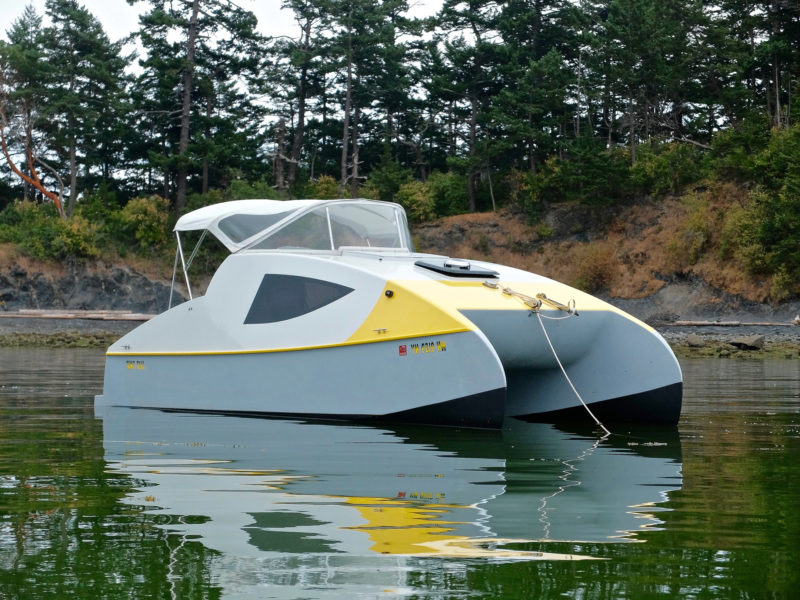
The Cat’s shallow draft and twin hulls open up options for anchoring in shallow coves. If the bottom is even and not too rocky, grounding out during a midnight low tide isn’t a problem.
D uring the boat’s first season we took a two-week cruise to British Columbia’s Broughton Islands. The cruise covered hundreds of miles, and we alternated between being the only boat in a secluded cove and being surrounded by the warm hospitality of wilderness float marinas. A comfortable 80-mile range and top speed of 10 knots allowed us to do plenty of exploring without concern for time or fuel. The EcoCat is comfortable in sea conditions of 2′ short, steep chop and can confidently deal with far rougher conditions.
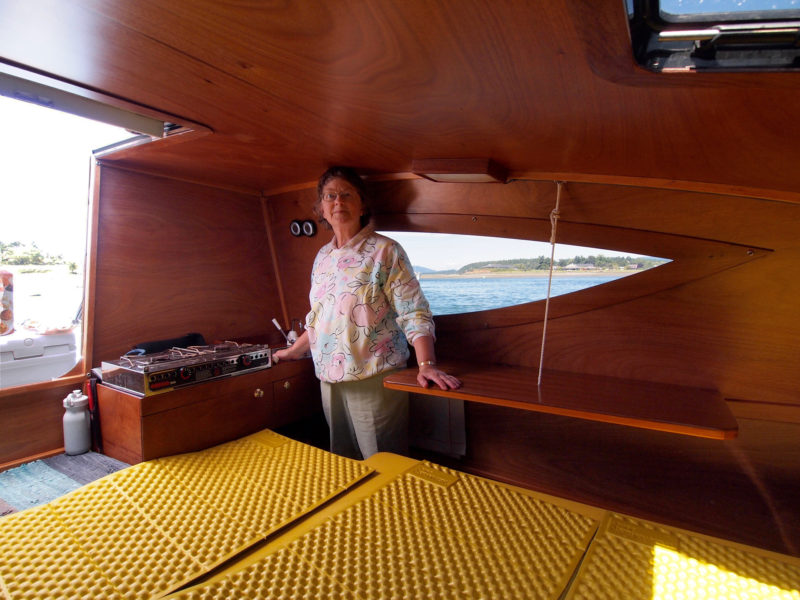
Having the lines of the Eco Cat in CAD files simplifies making alterations like raising the cabin roof to provide standing headroom.
This 8′-wide catamaran offers the stability and seakeeping of a far larger boat. There’s never a problem grabbing for a hot pan when another boat, zipping by to look at JUST ENUF, leaves its wake for us. There is plenty of room with a hanging locker and two cuddies for each person. Sleeping bags with integrated mattresses make a very comfortable double. When bags are folded over during the day, the large padded bridge deck area is very comfortable for sitting, cooking, and just hanging out. The starboard hull has a cushioned canoe seat atop the porta-potti. Just forward is hull storage for an inflatable kayak or two folding bikes and other bulky gear. The port hull has standing headroom at the sink and sit-down room for meal preparation with a flip-down table for dining.
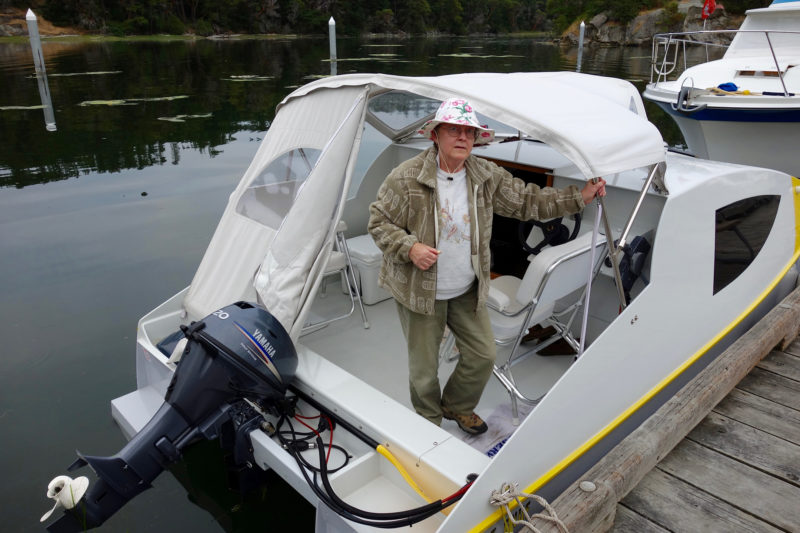
A single 20-hp outboard can outperform twin 5-hp outboards. Just behind the motor’s shaft you can see one of the extensions added to the hulls to improve the trim with the greater motor weight. The custom-made canopy doubles the Cat’s sheltered space.
The twin 5-hp outboards proved to be not enough power. They had no top-speed potential, pull-cord starting, and were noisy, especially with the steering linkage rattling between them. Worse, the tiny props had so little bite that docking maneuvers were a constant challenge. A repower with a single Yamaha 20-hp outboard yielded a 10-knot cruising speed, 15-knot top speed, and the same fuel economy as the twin 5s: 1 gallon per hour at any speed. Electric start, 6-amp charging capability, and a lightweight battery competed the package. A 1′ extension added to the stern of each hull helped offset the additional weight of the larger motor and its under-deck 12-gallon fuel tank. Docking was no longer embarrassing, and we could now talk while running 10 knots. The rougher the water got, the faster and smoother we would go. Life was good.
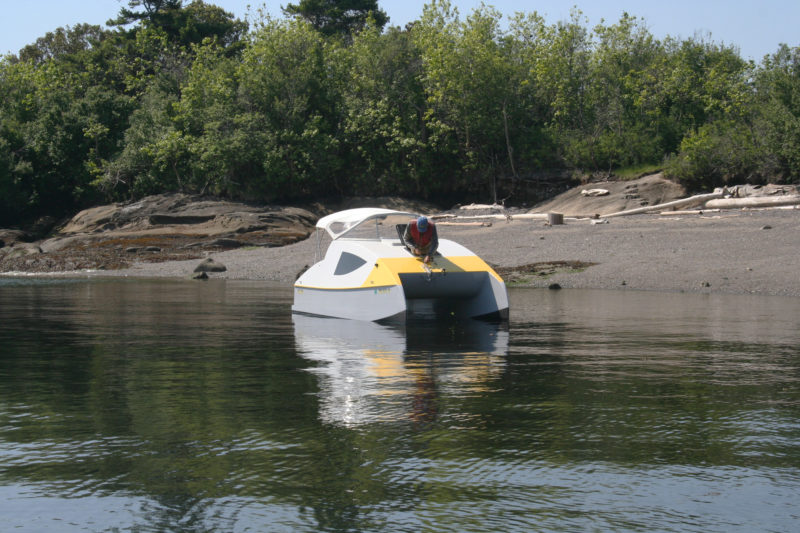
A hatch in the foredeck provides access to the bow for anchoring.
But as most of the weight was still aft with either engine arrangement, the EcoCat still squatted underway. One day, Mike Snook—experienced with super-large, high-speed Australian catamarans—suggested transom wedges and end plates as the cure. A 1″ x 4″ wedge was added like a trim tab to the each stern with skeg-like end plates added in line with the sides of the hull to contain the flow. The cat’s tracking was better, even with the previous centerline skegs removed. Trim was now level with clean entry and a very smooth exit. After a prop change, we had the same top speed with cruise speed reduced by 400 rpm for a noticeably quieter boat.
Outboards are designed to mount behind a transom with only the prop exposed below the hull. When centrally mounted on a catamaran, all of the lower unit below the bridge deck is exposed to bow wave convergence with lots of unwanted spray and, perhaps, added drag. We had tried several ideas on previous sailing catamaran but solved the problem on the EcoCat with a hull-mounted streamlined fairing that lets the motor think it’s on a transom.
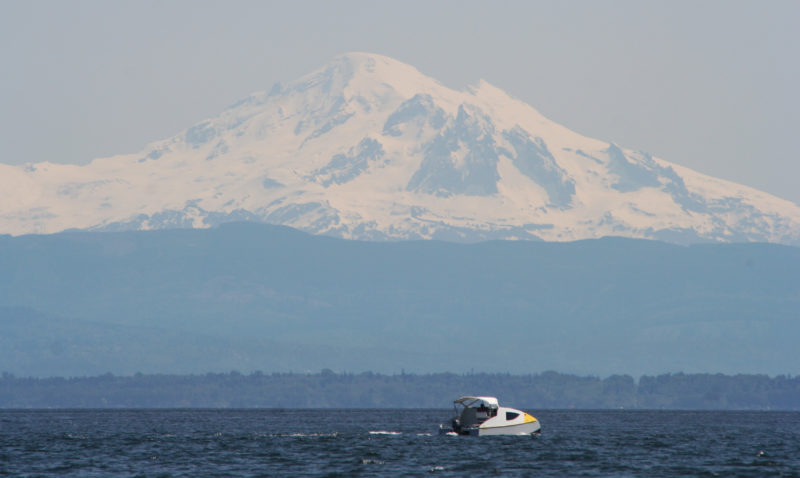
The EcoCat is quite at home in the broad reaches of Puget Sound that lie in the shadow of Mount Baker.
T he 10-knot cruise speed for our typical three-day, 50-mile round-trips lets us enjoy island life and not lose one day getting somewhere and another getting back. That’s the advantage of a gasser. It’s all about the destination, hanging out, enjoying a nice hike, being in a special place, especially for my wife Barbara and me. My solo trips continue to range farther and wider in all weather conditions.
Ron Mueller continues to design and build small boats and still rows most days in Bellingham, Washington. He started whitewater kayaking in the late ’60s, sailing in mid ’80s, and rowing in the ’90s when he founded Wayland Marine. Ron designed and built the Merry Wherry kits and was the Northwest dealer for Alden Ocean Shells and Echo Rowing until retiring in 2010.
Eco Cat Particulars
LOA/ 18′ (5.50m) Beam/8′ 2.4″ (2.50m) Draft/8.7″ (0.22m) Weight/606 lbs (275 kg) Capacity/1350 lbs (620 kg) Power/15–20 hp Construction/Approx. 400 hours
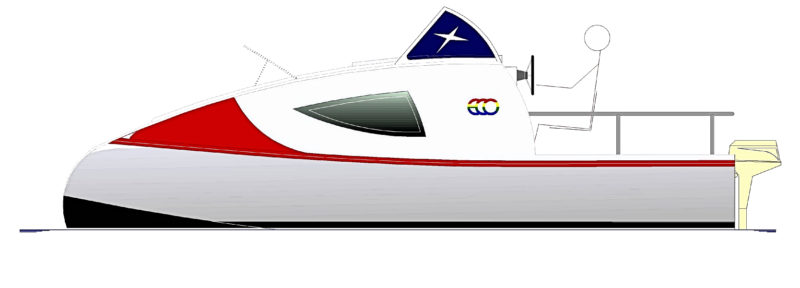
Plans for the EcoCat , with a digital manual and 16 pages of drawings as BMP or DFX files, come from Bernd Kohler at K-designs . A kit is also available.
Is there a boat you’d like to know more about? Have you built one that you think other Small Boats Monthly readers would enjoy? Please email us!
Share this article
Join The Conversation
We welcome your comments about this article. If you’d like to include a photo or a video with your comment, please email the file or link.
Comments (27)
I would really like to see a drawing of the modifications mentioned in the text. It sounds like the end product was significantly different from the original design.
Tim, JUST ENUF is built exactly to the furnished plans. Obvious additions were the cockpit sides and transom extensions when repowering. Plans are furnished as DXF files which may be printed out for “manual parts layout” or modified in CAD for CNC cutting. I hope this helps.
Form definitely follows function on your well built boat. The 20-hp outboard was a great idea and so were all of the modifications to get everything right.
Pete, thanks for your kind thoughts. Looking forward to seeing you on a Salish Sea beach soon!
I really enjoyed the article in the March issue of Small Boats Monthly about Ron Mueller’s JUST ENUF. Ron’s boat never fails to draw all kinds of attention when he’s pulled out on the beach or running with a group of other boats up here in the north Puget Sound, and looking carefully at his superlative build, one can easily see why. Though I am somewhat of a “traditionalist” at present, this boat looks like it could very well be in my build list sooner rather than later!
I love seeing articles from other Salish Sea folk. The photo with Mount Baker (Komo Kulshan is the name given to it long ago by the Lummi people) in the background is part of my life.
Vince, twins seem desirable but two 8.5-hp motors would use noticeably more fuel then a single 17-hp motor. Remote control would lend itself to a autopilot but complicated. Remember that each catamaran hull has a different turning radius in a turn. My previous sailing Jarcat had rudders set up with Ackerman steering (like a car). That’s probably not really needed for outboards. Just a thought.
I like the look of this craft. What would be the result if you went to twin 8.5-hp outboards which have the electric start and hardware to do twin rigs with remote control? Still the design appears to have a lot going for it. Enjoy it!
I’m just wondering if the deadrise at the end of each original hull was maintained on the 1′ extensions and if so, how the trim tabs were installed.
Mike, deadrise was just flowed out. The trim tabs are a solid wedge at the end of the hull about 4″ long and 1″ thick. An end plate (in line with hull side) contains the water flow for greater effect. The end plate is a skeg-like shape about 12″ by 4″ that provides better tracking than the original skegs on the keel centerline.
Most of the changes Ron made to the design—the hull extensions and other modifications—are incorporated in the plans. There are many ECO’s sailing world wide and it is my policy to update the plans to improve my designs. That applies not only for my ECO line of boats, but the others as well. By the way, I leveled out the deadrise of the extension to 0°.
Do the plans show the unique assembly method in case a builder wanted to have the parts CNC cut? Is the interior of the cabin also coated with epoxy?
Most parts were pre-coated and sanded (at least one side) prior to assembly. The plans are DXF files for display and would need to be, at least, nested for a CNC tool path prior to cutting. After importing to a CAD program, I added an inch in cabin height. Enlarged the windows, laid out cubby holes in the forward bulkhead and designed the cockpit sides with the same curvature used for the cabin. This is a real timesaver and provides great accuracy when having symmetrical parts and provides very smooth curves. The planking and cabin top is best (and easily) laid out directly on existing structure rather then CNC cutting. The construction was completed in just four months while attending to my normal business of selling rowing shells and making kits of same. Painting and canvas was “sent out” and fitting out was, at least, another month.
Thank you very much.
What is the contraption mounted on the forward hatch?
It’s a Nicro Solar Vent Fan. It runs mostly 24/7 as long as its self-contained battery is charged. There is enough leakage through the companionway hatch to keep the cabin dry during winter storage and summer nights when we’re sleeping aboard. We usually slide the main hatch open an inch or two at night (the dodger protects it from rain), and latch the foredeck vent hatch open rather the use the fan. Although fans may be quiet at first, they do develop a bit of noise after a few years.
I did some measuring. I wouldn’t have the ceiling height to flip the hulls over. Is there a real problem building them separately?
Walter, good news, the hulls are built separately. While the hulls were still upside down, I coated them with three coats of epoxy mixed with graphite powder. Those are the black surfaces in the video. This graphite/epoxy mix becomes “bottom paint” and is quite UV resistant, and does not need further painting.
The hulls are then rotated upright, aligned, and a 1/2″ plywood deck is glued to join both hulls. Everything else is built up from this deck—no need to turn the boat over! All of the painting is done from the waterline up. You could paint the bridge deck underside and inner hull sides while the boat is on a trailer.
What brand of windlass was used on JUST ENUF?
An 11-pound Bruce anchor with 10′ of chain is quite easy to haul with an arm-power winch while standing in the forward hatch.
I was looking at the thing below the hatch. Again, thank you.
Appromately how many sheets of plywood were CNC cut?
CNC cutting was used for all bulkheads, frames, cabin sides, cockpit sides, and interior trim— perhaps 10 sheets. The advantage of CNC is symmetrical parts, identical parts for both hulls and very smooth curves and cutout radius. When I had it (now retired six years), my ShopBot was the power tool of choice. Whatever I drew, I could cut and it would fit! Really miss it for my infrequent annual boat building project.
PS: The “thingy” below the hatch was a simple anchor bow roller.
Thank you very much for the information. I have found a local shop that has two ShopBot machines with the capacity of 66″ x 122″.
Greetings Ron, and congratulations on a well built project with very intelligent, yet simple modifications. My question is: Why were not twin 10-hp outboards considered when the twin 5s were insufficient instead of the single 20? Weight, perhaps? And could not the weight vs performance equation also be solved with transom trim tab re-engineering or re-positioning of gas tanks, etc? Love this boat. I am in Biscayne Bay, Forida. We get a chop, we get wind, squalls, hurricanes, etc. It’s a very open bay, but then we get to cruise to the Keys, the Everglades archipelagos, and a million places to explore and gunkhole. I have owned several sailboats here, all with retractable keels—a must if you’re on the bay and want to get off the beaten path of all the Olympic and Biscayne Bay Yacht Racing Association regattas.
Twin 5’s were specified as it was to be a EcoCat. The Honda 9.9 weighs on or about 100 pounds. The Honda rep insists that a single outboard (equivalent in HP to two twins) will always be more economical. I’d suggest today’s best choice would be a Suzuki 25, about the weight of the Yamaha 15/20. It’s said to be more economical and quieter. They sell a 30 (same block size) in the US but it only comes with power trim/tilt so the bracket would be dragging in the water. I hope this helps.
Comments are closed.
Stay On Course

More From This Issue
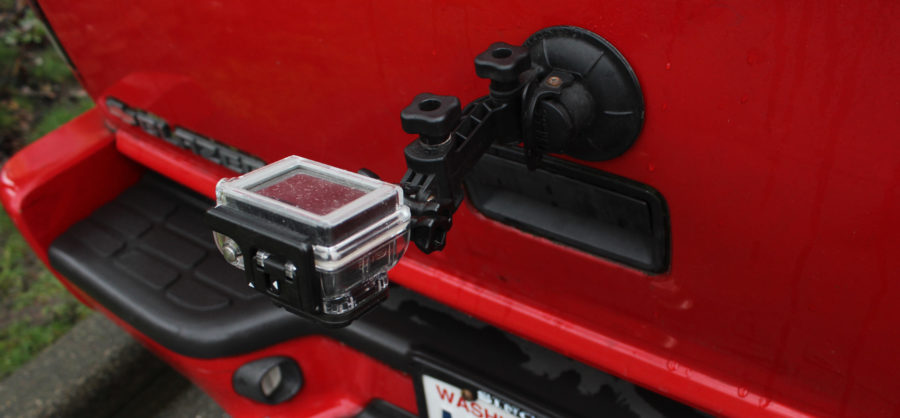
From The Editor
GoPro as a Trailer-hitch Cam
Harris Bucklin, a Small Boats Monthly subscriber, sent me this note after he had read our review of the iBall back-up camera in the January 2016 issue: “You gave me...
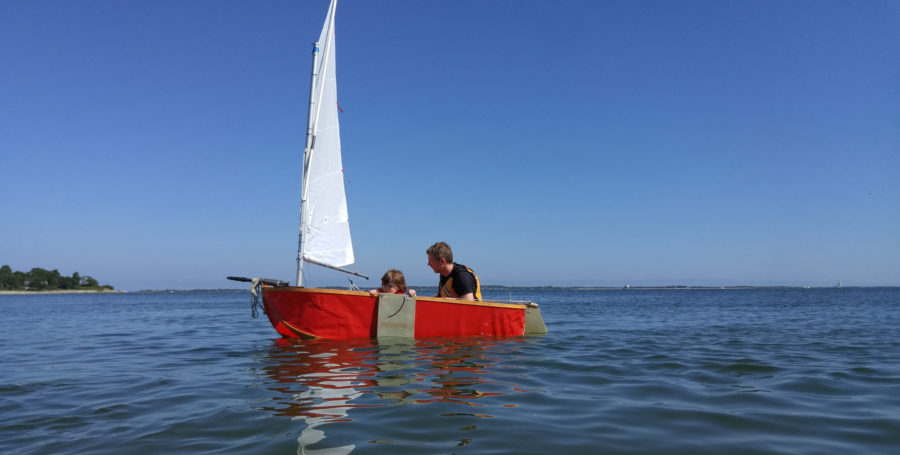
Zach, my sailing buddy/guru, had been shopping online for a sailboat for a co-worker when out of the blue, he sent me this instant messaging note: “Matt, I really think…
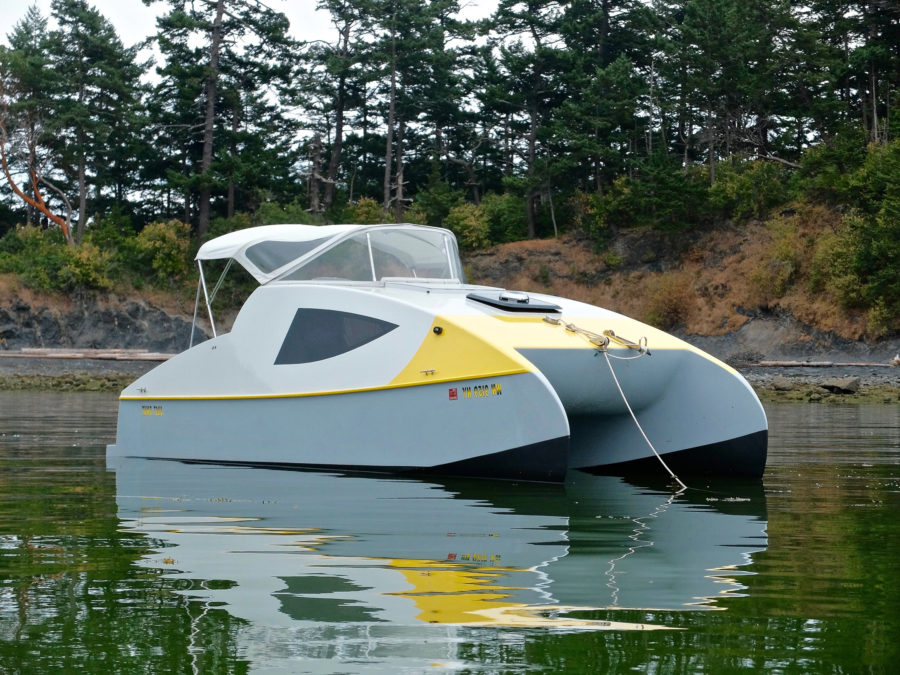
Was it time for another boat? In the 1980s, it was a 16′ sailing dinghy that awakened my wife Barbara and me to the beach-cruising pleasures of the San Juan…
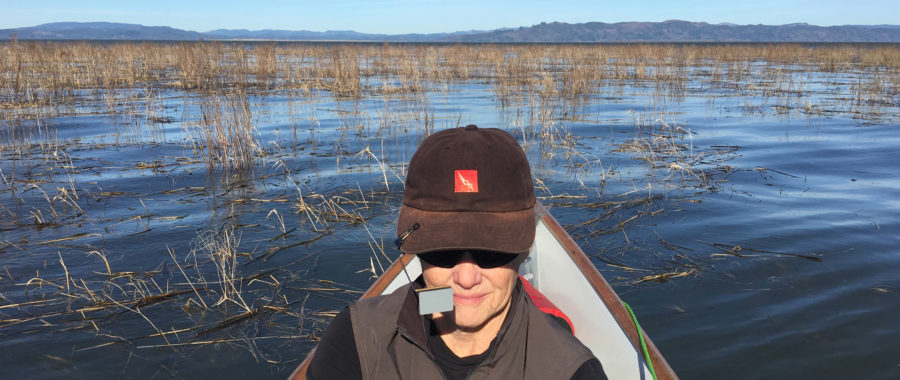
Taking Refuge
If there’s one thing I’ve learned about the rowing on the Lower Columbia River, it is to go with the flow. Winters there tend to be gray, windy, cold, and…
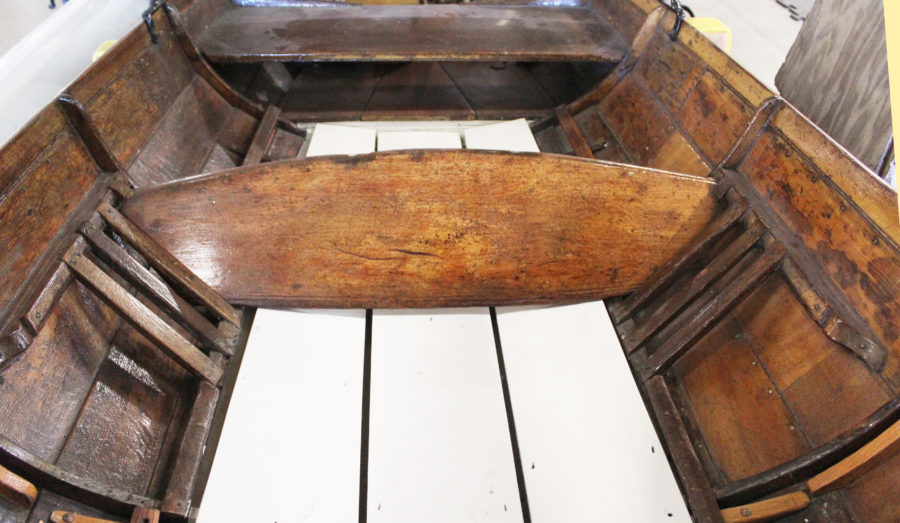
Foot Braces
To row with power you need to have your feet firmly braced against something solid enough to take your full weight. In some traditional boats you can get by with…
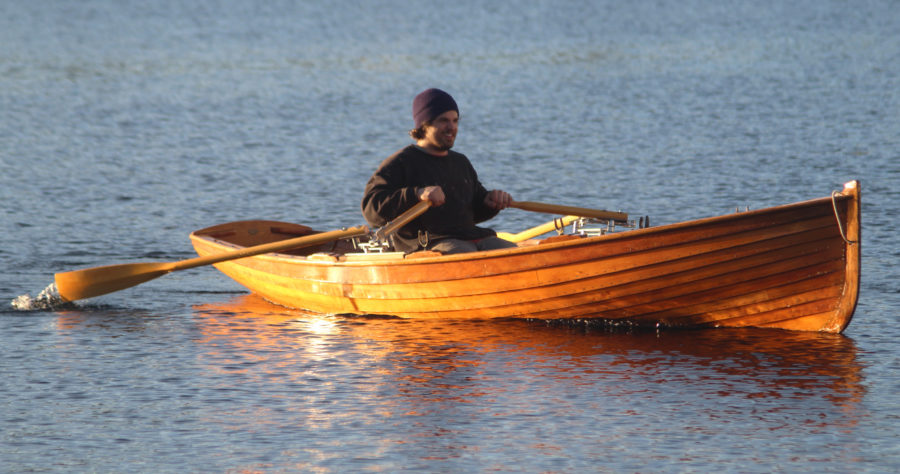
Product Reviews
Whitehall Tender
Oars with Elbows
Forward-facing rowing systems are nothing new. You’ll find many old patents for devices that use gears or pivots and connecting rods to get rowers to see where they’re going. The…
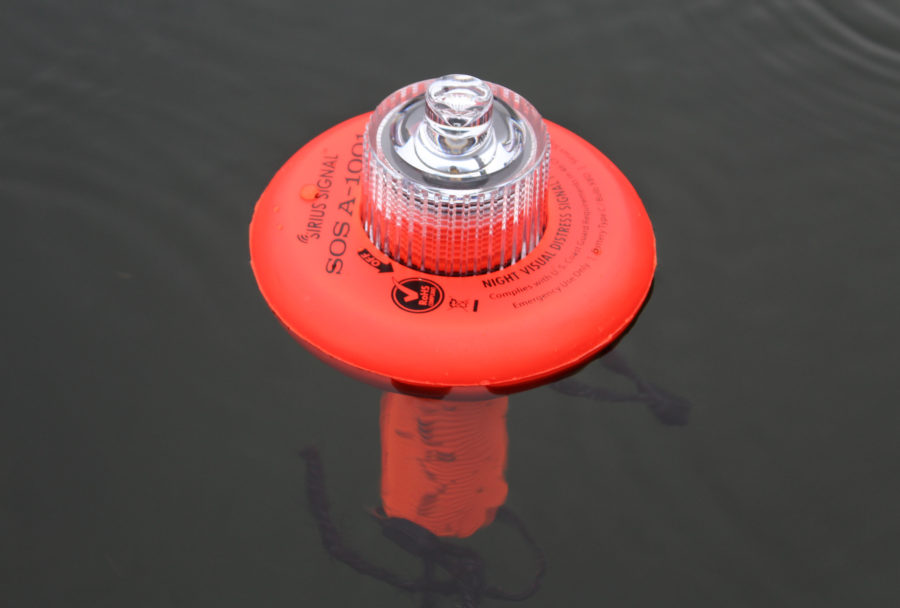
SOS Distress Light
The older I get, the more safety conscious I become. Every year I add to the emergency kit I bring on my small-boat adventures, but as yet I’ve never carried…
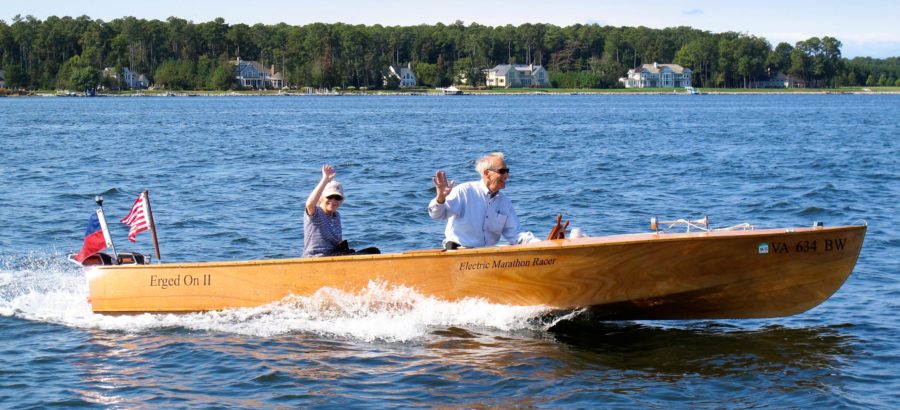
Reader Built Boats
ERGED ON II
Ned Farinholt of Winchester, Virginia, had a career as an electronics engineer, so it’s no surprise that he took an interest in electric boats. They had fallen out of favor…
More Boat Profile
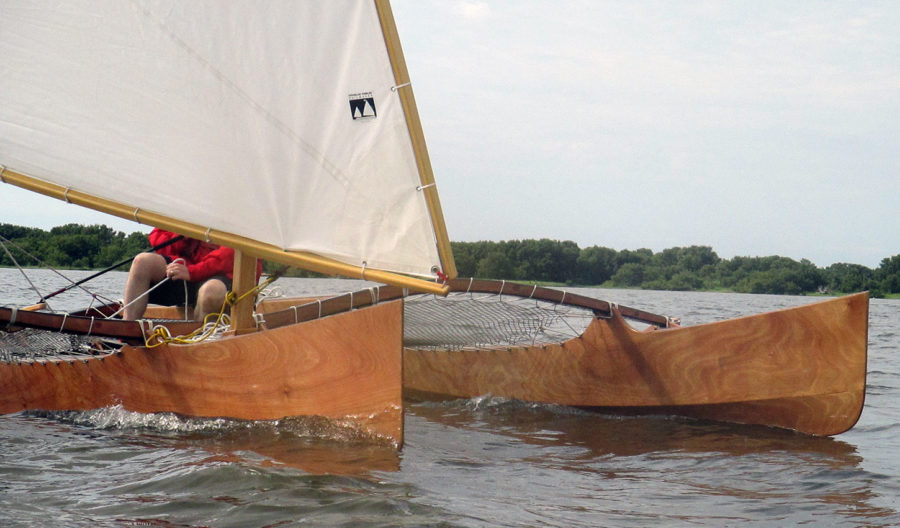
Outrigger Junior
Long before Europeans ventured to the new world, sailing dugout canoes fitted with outriggers sailed the waters in Southeast Asia and were used for migration throughout the Pacific region. The…
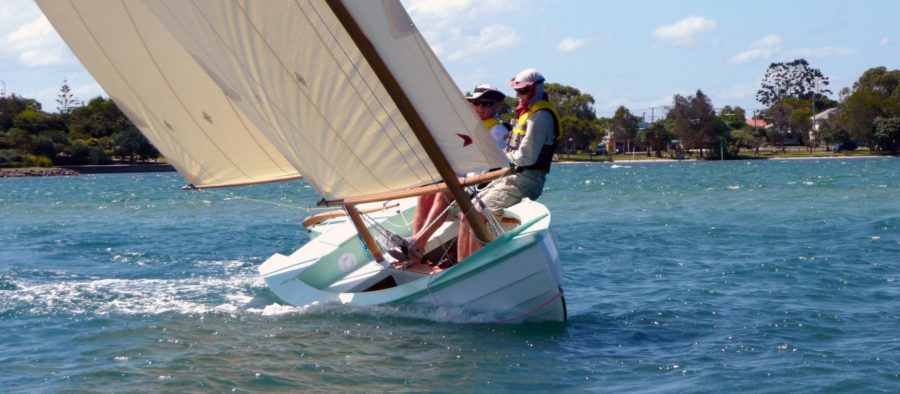
I met this great bloke, Ross Lillistone, a classy sailor, designer, and builder of boats, at a boat show in 2005 and asked him to sell me plans and give…
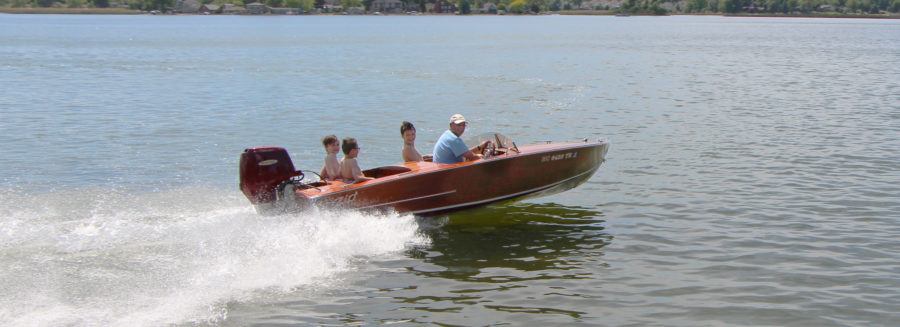
"I am frequently asked why I built a boat, and particularly, why I built a Glen-L Zip. The first part of the question is easy to answer: I love to…
Subscribe Today!
Become a subscriber today and you’ll recieve a new issue every month plus unlimited access to our full archive of backlogged issues.
Already a subscriber? Sign In
Subscribe For Full Access
Flipbooks are available to paid subscribers only. Subscribe now or log in for access.
Sailing In Style
Search this blog, riding the green wave: the pioneers of eco-friendly catamarans.
As the world continues to struggle with climate change, the demand for sustainable solutions continues to grow across industries. Within the maritime world, eco-friendly yachts are at the top of the list. Catamarans combine luxury and sustainability in a unique way. Electric and hybrid engines power eco-friendly boats that not only reduce GHG emissions but also offer a quieter and more comfortable sailing experience. As we recently visited Monaco’s yacht show, we also decided to re-evaluate our plans and start looking for eco-friendliness in our blue water cruising.
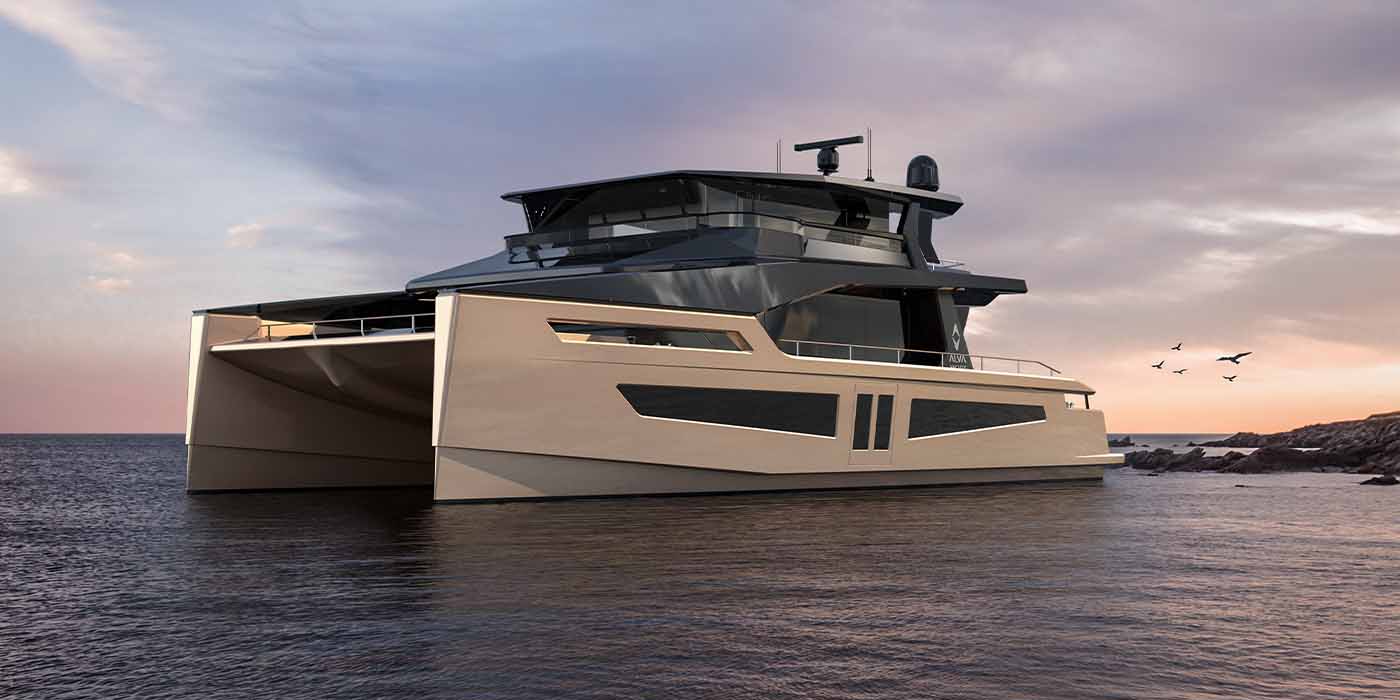
When it comes to size, eco-friendly boats don’t come at a huge price tag (about 800k approx), but they come with fewer maintenance costs, lower fuel consumption and greater independence. Let’s explore some of the manufacturers that are leading the way with eco-friendly yacht design. We took a more in-depth look at the existing models and requested the shipyards to provide their technical specs, price and any additional information they could provide.
Silent Yachts
Technical specifications.
- Length Overall (LOA): 54'10"
- Beam: 27'8"
- Draft: 3'11"
- Displacement: 38,000 lbs or 34,400 lbs
- Electric Motors: 2x 250-kW Dana TM4 E-motors
- Solar Generator: 1x 10,000 kWp
- Generator: 1x 100-kW Volvo Penta
- Fuel Capacity: 132 gal or 422 gal
- Water Capacity: 160 gal or 264 gal
Design and Usability
Environmental impact.
Shipyard : Italy Vessel Highlights : Silent 55 , Silent 60 , Silent 80 Overview : Silent 55 Solar-Electric Power Catamaran ( Power and Motoryacht ) Performance Reports : Reviewed for self-sufficiency in solar power utilization ( Silent 55 ), Review by Robb Report , Honest Review ( YouTube ) Starting Price : $1.55 million
Alva Yachts
- Length Overall (LOA): 18.40 m (60 ft)
- Length of Waterline: 17.80 m
- Beam: 10.20 m
- Draft: 1.2 m
- Displacement: 35,000 kg (35t)
- Propulsion:
- Electric Engines, 2 x 100 KW up to 2x350 KW
- Generator: 25 KVA up to 100 KVA - frequency driven DC
- Battery Capacity: 150 - 280 kWh
- Solar Power: 20 KW Peak
- Fuel: 500 - 1000 L
- Fresh Water: 500 - 1000 L
- Hot Water: 200 L
- Greywater Tank: 400 L
- Blackwater Tank: 400 L
Shipyard : Germany Vessel Highlights : Ocean Eco 60 , Ocean Eco 90 Overview: All available models via itboot.com Performance Reports : Reviewed for the blend of luxury and sustainability ( boats.com ), Next level electric in the Alva Eco 60 ( Sails Magazine) , ALVA ECO 60 Solar Powered Yacht ( YouTube ) Starting Price : €3.9 million
Nova Luxe Yachts
- Length Overall (LOA): 44'
- Beam: 21.5'
- Maximum Draft: 3'5"
- Bridge Clearance: 18'
- Dry Weight: 22,000 lbs
- Serial Hybrid:
- Standard Motor: Torqeedo Deep Blue 55kW, 80hp
- Upgraded Motor: Torqeedo Deep Blue 100kW, 160hp
- Parallel Hybrid:
- Engine 1: Yanmar 4LV150, Diesel, 150hp + Electric Motor, 20kW
- Engine 2: Yanmar 4LV150, Diesel, 150hp + Electric Motor, 20kW
- Maximum Speed: 16+ knots (Serial Hybrid), 18+ knots (Parallel Hybrid)
- Cruising Speed: Operate all day as electric at 6+ knots for 4+ hours
- Solar Array: 7 kW
- Battery Power: 92/172 kWh of Marinized LFP batteries
- Genset: 20kW Fischer Panda
- Electric System: Efficient 24v System with 110v/220v Appliances
Shipyard : USA (NYC) Vessel Highlight : ELight 40 - Elight 70 Overview : ELight 44 ( Multihulls World ) Performance Reports : Demonstrated accurate performance projections during sea trials ( Great Lakes ) Starting Price : $1.2 million
Principal Dimensions:
- Length Overall (LOA): 15.70 meters (51.5 feet)
- Beam: 8.40 meters (27 feet 7 inches)
- Draft: 1.30 meters (4 feet 4 inches)
- Displacement: 16,000 kg (35,280 lb)
- Solar Power : 17,000 W of peak solar power with a remarkable ratio of over 1 kW per displaced tonne of water, which is far beyond any other blue water CE Cat A yacht in this size range.
- Wingsail : The Zen 50 can be equipped with a fully automated wingsail developed by Ayro, which acts as a range and speed extender.
- Electric Propulsion : Powered by a high-capacity battery bank, allowing the Zen 50 to achieve speeds of up to 14 knots and maintain high continuous speeds indefinitely.
- Battery and Energy System :
- Battery Bank: 160 kWh capacity designed to function for days in complete safety with minimal solar energy harvest and no wind
- Maximum Speed: 14 knots
- Continuous Cruising Speed: Varying between 6 and 10 knots.
Additional Features
Shipyard : Malta Vessel Highlight : ZEN50 solar electric catamaran Performance Reports : Meet the Zen Yachts ZEN50 ( Inside EVs ) Starting Price : €2.4 million
Herley Boats
- Length Overall (LOA): 10.2 m
- Beam: 4.7 m
- Draft (including propeller): 0.77 m
- Engines: 2 x 100 kW peak electric motors, 60 kW continuous output, brushless, permanent magnet
- Diesel Generator: 120 kW
- Fuel Capacity: 640 L
- Water Capacity: 400 L
- Maximum Speed: 21 knots
- Cruise Speed: 14 knots
- Battery Only Max Speed: 12 knots
- Cruise Range (Hybrid): 1300 NM at 6 knots and 700 NM at 8 knots
- Battery Only Range: 34 NM at 6 knots and 18.5 NM at 8 knots (Solar input not included in these calculations)
- Battery Bank: 60 kWh Lithium-ion
- On-board Charging: 120 kW Diesel permanent magnet generator
- Material: 5083 Marine Grade Aluminium
- Fendering: Full length Aluminium Sheer Bump rail Aft Quarter Rail
Soel Yachts
- Length Overall (LOA): 11.80 m (39 ft)
- Beam: 5.80 m (19 ft)
- Draught: 0.70 m (2.3 ft)
- Displacement: 6 ton (13,200 lb)
- Solar Power: 8.6 kWp
- Battery Capacity: 2x 60 kWh
- Electric Motor: 2x 30 kW
- Maximum Speed (V_max): 13 knots
- Service Speed (V_service): 8 knots
- Break Even Speed (V_break even): 6 knots
Environmental Impact and Additional Features
Hh catamarans.
- Length Overall (LOA): 14.23m / 46ft 8in
- Length of Waterline (LWL): 13.28m / 43ft 7in
- Beam: 7.15m / 23ft 6in
- Draft (fixed keels): 1.52m / 5ft 0in
- Displacement (OC model): 8,750kg / 19,290lb
- Standard Propulsion:
- Electric Propulsion with Diesel Hybrid backup.
- Solar Capacity: 3,190 watts
- Hydro Power Generation: Shaft-drive folding propellers
- EcoDrive System:
- Silent fume-free motoring at 7.5 knots, instant torque for maneuvering, hydro-regeneration while sailing with diesel engines as a backup
- Construction Material: Carbon and Epoxy
- Features: Pre-preg carbon fiber C-shaped daggerboards
Electric Yachts
Solar electric boats.
- Sunreef Yachts
Sustainability at sea: Sunreef is integrating recycled plastic bottles into solar electric yachts
Sunreef Yachts is already a solar electric boatbuilder recognized for its sustainability efforts in the maritime industry but is now taking things a step greener. The company is now integrating recycled PET bottles into its solar electric yacht production process.
Sunreef Yachts has been operating out of Gdansk, Poland, for over 20 years alongside a newer footprint established in the United Arab Emirates. From day one in 2002, Sunreef has been pushing the boundaries of sustainable marine travel, launching the world’s first 74-foot luxury oceangoing catamaran with a flybridge.
Sunreef Yachts currently has hundreds of its boats sailing waters across the globe, showcasing the company’s lineup of sustainable, all-electric propulsion and advanced solar panels. Its current portfolio consists of eco-friendly sailboats and massive solar electric catamarans ranging from 60 to 100 meters in length.
In April 2024, Sunreef introduced a new 40m electric yacht called the Eco Explorer . One month later, Sunreef shared a new sustainability strategy that will integrate hundreds of thousands of recycled polyethylene terephthalate (PET) bottles into the superstructures of its electric yachts.

Sunreef’s electric yacht reuses 600k recycled PET bottles
As part of a new initiative to maximize energy efficiency and, above all else, sustainability, Sunreef Yachts Eco’s R&D team will integrate a structural foam composed of up to 100% recycled PET materials into the production of its solar electric yachts and sailing catamarans.
By integrating this recycled material, Sunreef can achieve even more eco-conscious electric yacht construction practices while furthering sustainability in a maritime segment that quickly embraces electrification .
In addition to being 100% recyclable, Sunreef shared that the recycled thermoplastic core offers additional benefits in electric yachts and catamarans, such as high resistance to process temperatures, exceptional chemical resistance, strong adhesion, and other mechanical properties.
For added perspective on the impact the recycled material can have on the industry, Sunreef said one of its 80-foot sailing catamaran requires about 2.4 tons of the structural foam, equating to approximately 600,000 recycled PET bottles finding a second life at sea within the superstructure rather than floating around as pollution.
This is the kind of news we love sharing with you readers and provides further evidence that large boats can not only be 100% electric but may soon be 100% recyclable.
FTC: We use income earning auto affiliate links. More.


Scooter Doll is a writer, designer and tech enthusiast born in Chicago and based on the West Coast. When he’s not offering the latest tech how tos or insights, he’s probably watching Chicago sports. Please send any tips or suggestions, or dog photos to him at [email protected]

Manage push notifications

Designed by Bernt Kohler.
Coastal cruising catamaran.
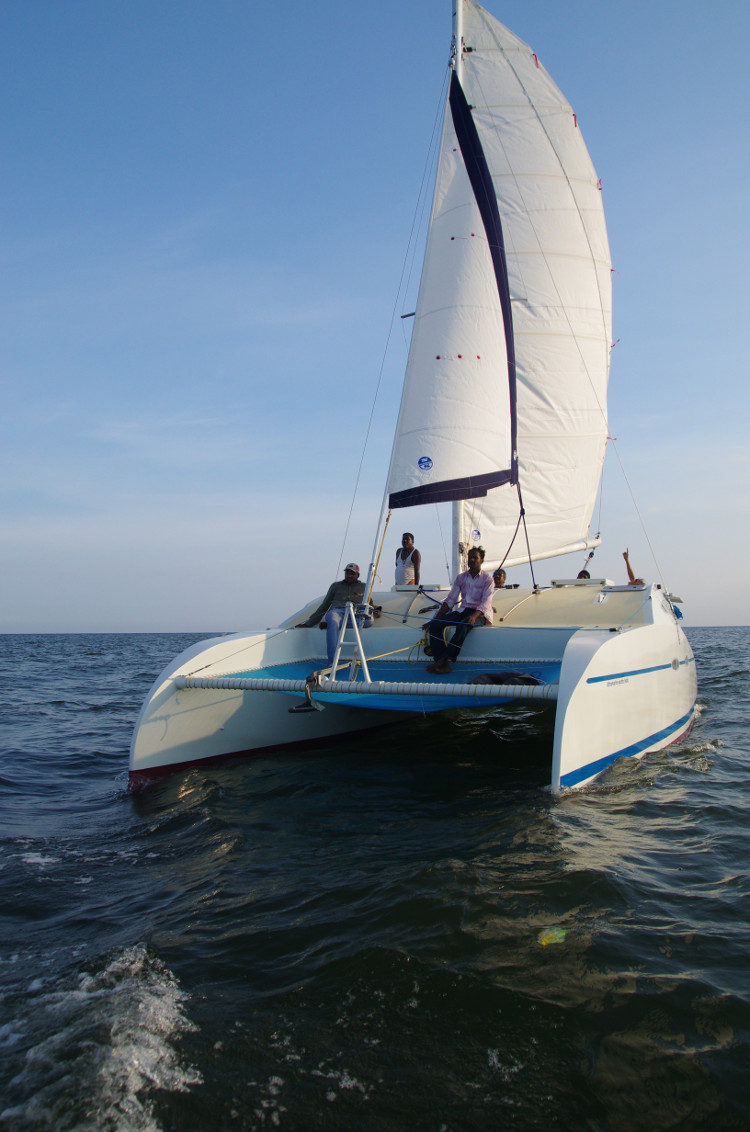
SPECIFICATIONS
Media gallery.

- Share full article
Advertisement
Supported by
A Boat Designed to Be a Breath of Fresh Air
The creators of the latest vessel from Azimut Yachts went to great lengths to reduce its emissions, but even they won’t call it green.

By Ian Volner
Reporting from Milan
This article is part of our Design special section about water as a source of creativity.
In the middle of Milan Design Week last month, in the middle of the Bagni Misteriosi — a historic bathing complex in the Porta Romana neighborhood — the Italian luxury shipbuilder Azimut Yachts hosted an unusual exhibition. It was a celebration of the company’s latest offering: the Seadeck 6, which made its debut last year and features interiors by the design team of Matteo Thun and Antonio Rodriguez.
Having been lowered into the facility by crane, the nearly 60-foot vessel was set afloat in an outdoor swimming pool. There it bobbed, traversed by hordes of well-coiffed guests while a concealed apparatus shrouded it in bursts of atmospheric steam. Surreal, elegant, not a little absurd, it was a scene straight out of Fellini, with overtones of Werner Herzog’s boat-hoisting epic “Fitzcarraldo.”
But the thing that made it most unusual? “Azimut wanted to make this the most sustainable boat on the market,” Mr. Rodriguez said. “We tried to do that.”
The ultimate playthings for the ultrawealthy, high-end pleasure craft would not seem optimal candidates for greening. Yet a growing number of manufacturers and designers are trying to change that, producing yachts both large and (comparatively) small assembled from fewer and less carbon-intensive materials, requiring a fraction of the power to run and drawing more of their energy from renewable sources.
In a peculiar twist for an industry uniquely exposed to supply-chain shocks and the vicissitudes of geopolitics (the loss of the once-lucrative Russian market continues to smart), global brand leaders appear to be making the move toward energy efficiency of their own accord, rather than in response to any explicit demand from their clientele.
“We will have to see if the world is ready,” said Giovanna Vitelli, Azimut’s chairwoman, as she stood aboard the Seadeck 6 during its not-quite maiden, not-quite voyage.
It is an approach that entails some risk. In January, Silent Yachts — an Austrian solar-electric catamaran company with facilities in Fano, Italy — was reported to be approaching bankruptcy amid problems with both its corporate parent and a key subcontractor. A former client stepped in to rescue the brand from insolvency, yet challenges remain. In a recent interview with the trade publication Superyacht News, the company’s new chief operating officer, Fabrizio Iarrera, spoke of the “costs associated with creating an entirely new market.”
Still, the push toward more sustainable yachting appears to be barreling forward, part of a broader shift in the role of design in the industry. Seven years ago, Bonetti/Kozerski Architecture in New York — known for its plush hotel interiors for the hospitality magnate Ian Schrager — was invited by Azimut’s sister company Benetti to develop a new yacht concept, the Oasis. It was one of the rare instances in which Benetti, founded in 1873, had sought out collaborators with no previous maritime experience, and all parties took it as an opportunity to import a set of values they viewed as lacking in the boating world.
According to Enrico Bonetti, the architecture firm’s co-founder, boat design previously favored grand spaces that no one actually liked. “There’s always this big table nobody’s using, then you step into another place with shiny things,” he said. “We didn’t follow that.” With its open, airy living space, wood paneling and notable lack of gold leaf, the Oasis represented a more humane vision for the yacht of the future, one constrained by at least the appearance of refinement and reserve, though it was ritzy nonetheless.
That low-key tendency is very much in line with the decarbonization campaign now underway at Azimut and other builders. In recent years, design studios like Zaha Hadid Architects and Pininfarina have turned out yacht proposals that pair sleek visuals with reduced reliance on fossil fuels; later this year, Yves Béhar, the Swiss-born product and furniture maestro, will unveil his own take on the trend — a catamaran designed for an as-yet unnamed manufacturer. “It’s essentially an E.V.,” said Mr. Béhar, who was also in Milan for the design fair.
Underlying the designer eco-yacht phenomenon is the intuitive sense, as Antonio Rodriguez put it, that “silent luxury” is fast displacing opulence. Where previous generations of yachters sought to flaunt their wealth, today’s owners may be less keen to draw attention to their own affluence. In reducing their carbon footprint, boatmakers are hoping to lure customers eager to reduce their profile, while still allowing them to ply the seven seas in style.
The Seadeck 6 certainly does that. With a crisp, white exterior — the work of the veteran yacht designer Alberto Mancini — the ship sleeps up to eight in three below-deck cabins. Topside, guests can sprawl in fore and aft lounges, or take lunch prepared in a semi-concealed galley, served on an elegant foldout table. The interior palette is muted, the contours soft, and everywhere, Ms. Vitelli said, the intention was to let people “feel close to water” rather than immuring them in an oceangoing penthouse.
Relatively speaking, the Seadeck’s ecological credentials are also impressive. Nearly every feature has been retooled for minimal environmental impact: replacing the customary teak deck with sustainably sourced cork; covering the walls and upholstering the seating with organic and recycled materials; even sealing the hull with something the company refers to as an ‘eco-gel finish.’” Most important, the craft incorporates a still-novel (for marine propulsion) hybrid engine, capable of a top speed of 33 knots with the ability to navigate about 200 miles offshore — enough for a quick spin from Fort Lauderdale to the Bahamas.
Add it together, and the company claims the Seadeck 6 and its larger cousin, the 71-foot Seadeck 7, achieve an operational carbon output 60 percent that of comparable vessels.
It’s a start, but only that. A comparative analysis with a similarly sized Azimut product — coupled with statistics from the Environmental Protection Agency — suggests that the cruise from Fort Lauderdale to Nassau would contribute roughly 4,400 pounds of carbon dioxide on the Seadeck 6, well over what the average American produces in a month.
And then there are the more immediate costs: around $2.8 million for the Seadeck 6 and $4.25 million for the Seadeck 7. Ms. Vitelli said the company hopes that enough buyers will come aboard to make price reductions possible in future.
A lot is riding on these hopes. Elsewhere in Milan, at the giant exhibition hall of the Salone del Mobile furniture fair, a talk session with a group of yacht experts underscored the stakes: During the panel, Stefano de Vivo, the chief commercial officer of the luxury yacht brand Ferretti Group, presented a slide showing Italy’s dominance in the custom-yacht sector, with domestic manufacturers taking a large share of the $9 billion global marketplace.
Mr. de Vivo declared sustainability essential to shipbuilding’s ongoing success and spoke of a general convergence with the design field at large. “As a shipyard, we’ve had to become less ‘marine,’” he said.
Back at the Bagni Misteriosi, mariners did seem in somewhat short supply, as various design lovers and Salone personalities (including the celebrated architect Michele de Lucchi, who helped create an on-site installation for Azimut) swanned around the bathhouse garden and its waterborne centerpiece. As an image of an ecologically sensitive future, the spectacle seemed off the mark — but then the Seadeck’s creators are careful not to make any overly sweeping claims as to whether their yacht, or any yacht for that matter, can truly be deemed an ecological asset.
“We don’t really like the word ‘sustainable,’” Mr. Rodriguez said. “We prefer to say it’s ‘conscious.’”

IMAGES
VIDEO
COMMENTS
The ECO 6 looks like the ECO55 cruiser, but it is a completely new design. The small increase of only 0.5m and increasing the total beam to 2.84m created a lot of possibilities. The cabin is much bigger; the boat now sports an enclosed bath room. There is a lot more stowage room.
The extra 50 cm (18") compared to the ECO 5.5 provides more living space - thanks to the raised deck, something surprising for a catamaran only 2.84 m (9'4") in beam. There is a saloon that can be converted into a double berth - positioned athwartships -, a galley in the starboard hull and a single berth - accompanied by a heads ...
The ECO 6 is clearly an enlarged version of our well known ECOnomy cruiser. The ECOnomy cruiser is 5.5m long with a beam of 2.5m. One of my clients in Brazil, who by the way has made these beautiful renderings of the boat, wanted to use the Gunter rig and bigger ECO. By looking at the possibilities new ideas could be realized - bigger cockpit ...
The ECO 6 coastal cruiser catamaran for amateur construction. An easy to build wood/fiberglass/Epoxy constrution. Building step photos and renderings from th...
ECO6 is a catamaran for amateur construction in the plywood, glass, and Epoxy system. For more information go to https://ikarus342000.com/ECO6page.html
ECO 6 catamaran photos.
Sunreef Yachts Eco catamarans are the future of sustainable yachting. With a 360° approach to eco-responsible cruising, they offer cutting-edge green propulsion solutions, naturally-sourced finishing materials, smart energy management and new technologies including a proprietary composite- integrated solar power system produced in-house to power their newest range of solar catamarans.
This makes Sunreef Yachts Eco the lightest marine solar power system producer in the solar catamaran market. Each of the solar cells administered into the Sunreef solar catamarans are ISO 9001:2015 certified and offer a peak performance of ±24 percent, this is 25 to 30 percent more power compared to conventional cells.
The perfect mid sized electric solar catamaran. The OCEAN ECO 60 is an innovation packed solar assisted electric long-range cruiser that will perfectly suit customers who like to cruise and explore while yachting.Designed with luxury, safety and cruising comfort in mind, it is an example of the latest technological developments in the field of self-sufficient yachts surpassing its competition ...
The ECO 62 is a catamaran houseboat. Compared to houseboats of the same size the boat is light and a bit more boat as house. Specifications: L.o.a.-6.20 m: Beam-2.5 m: Draft -0.23 m: Weight-410 kg: Weight max. CWL-890 kg: Power-Variable: The empty weight of about 410 kg is not much for a craft of this size with this lot of accommodation. ...
The Sunreef Yachts Eco harvest power from the sun more efficiently than most solar catamarans.First in the world In-house pattented designed and manufactured by the shipyard, Sunreef Yachts' solar panels are fully-integrated with the composite bodywork, vastly increasing the amount of solar power generated.
OCEAN ECO 90f-HY2x 250 kW gearless electric drive & 2x 456 KW diesel engine, gearbox, clutch, common shaft - with 5 different drive modes. Cruising Speed: 8-10 kn, Top Speed 15-16 kn. Solar Input: 40 kWp , with „ Solar Roof" glass tiles. Batterie capacity: 240 kWh - 360 kWh.
First unveiled during Cannes Yachting Festival 2019, the Sunreef 60 E was second to join Sunreef Yachts Eco's range of sustainable catamarans.With electric propulsion and smart energy management systems, eco yachts offer a silent, vibration-free cruising experience which complements its responsible approach towards nature. The owner's fascination with cutting-edge technology, safety ...
ECO 6: A catamaran for a self-builder... https://www.multihulls-world.com/news-catamaran-trimaran/eco-6-a-catamaran-for-a-self-builder #multihull...
ECO 55 Power Cat Plans. The ECO 55 power catamaran is an affordable DIY power catamaran. As the owner proved the boat is a capable coastal cruiser. The inside layout is the same as for the ECO55 sail version but the underwater shape is changed. The cockpit is wider and has a size of 1,45m x 2 m. With the bigger size normal deck chairs can be used.
SALES MANAGER. Windelo is a new conception brand of innovative catamarans. Ecology is at the heart of the company with the ambition to significantly reduce the environmental impact of our boats. A range of 44 to 60 foot catamarans offering sailors the opportunity to sail with pleasure and safety on eco-friendly boats.
ECO 6 catamaran pictures. Sailing, building, in and outside. a boat for amateur construction. Plans are available https://ikarus342000.com/ECO6page.htmland D...
Sustainable. The Sunreef 60 is an all-around sailing leisure yacht ideal for exclusive getaways, charter, and transoceanic adventures. This model boasts a combination of exterior and interior areas easily flowing into one another. A clever bridge deck and superstructure design allow for a superior level of comfort onboard whereas the generous ...
At 5.5 meters, it was about the same size and accommodation as our 6-meter sailing cat, and still trailerable behind our compact SUV. The twin 5-hp outboards specified in the plans were to drive the EcoCat at an economical 10 knots and spin it around in circles. Having them mounted on the transoms should eliminate weed pickup, as well as the ...
Being a solar and wingsail electric catamaran, the Zen 50 operates with zero emissions, making it an eco-friendly choice for the environmentally conscious sailor. The ability to sail continuously at speeds between 6 and 10 knots without using a genset showcases the Zen 50's self-reliant nature, promising a clean and eco-friendly sailing ...
Its current portfolio consists of eco-friendly sailboats and massive solar electric catamarans ranging from 60 to 100 meters in length. In April 2024, Sunreef introduced a new 40m electric yacht ...
The Sunreef 80 is an all-around luxury sailing catamaran, ideal for exclusive getaways, charter, and transoceanic adventures. This model boasts a combination of exterior and interior areas easily flowing into one another. The clever bridge deck and superstructure design allow for a superior level of comfort onboard, whereas the generous teak ...
Designed by Bernt Kohler. Coastal cruising catamaran. SPECIFICATIONS. Length Overall: 7.75 m: Length: 7.50 m: beam: 4.50 m: Draft
The Seadeck 6 by Azimut Yachts on display at the Bagni Misteriosi during Milan Design Week. ... Silent Yachts — an Austrian solar-electric catamaran company with facilities in Fano, Italy ...
Augustine ECO Tours offers the guided Kayak, Catamaran Sailing and Eco Boat tours along the b...". St. Augustine Eco Tours | 🐬💦EXPLORE ST. AUGUSTINE by water!